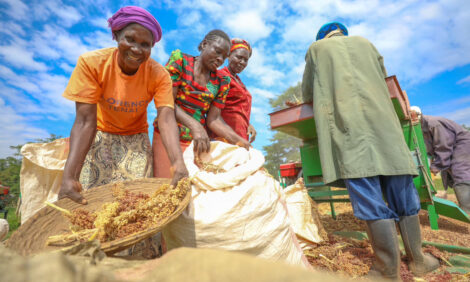



Weekly global protein digest: HPAI continues to spread in US, COVID-19, China buying pork
Market analyst Jim Wyckoff shares highlights from the global protein marketUS pork export sales down, beef up in latest week
USDA Thursday reported US pork net sales of 25,400 MT for 2022 were down 40 percent from the previous week and 4 percent from the prior 4-week average. Increases primarily for Mexico (12,800 MT, including decreases of 200 MT), China (3,600 MT, including decreases of 300 MT), South Korea (2,100 MT, including decreases of 100 MT), Japan (2,000 MT, including decreases of 500 MT), and Honduras (1,200 MT), were offset by reductions for Chile (100 MT). Exports of 28,500 MT were down 5 percent from the previous week and 6 percent from the prior 4-week average. The destinations were primarily to Mexico (11,900 MT), Japan (5,200 MT), China (3,600 MT), South Korea (2,600 MT), and Canada (1,500 MT).
Beef: Net sales of 27,500 MT for 2022--a marketing-year high--were up 16 percent from the previous week and 36 percent from the prior 4-week average. Increases were primarily for China (10,400 MT, including decreases of 100 MT), Japan (6,400 MT, including decreases of 300 MT), South Korea (3,700 MT, including decreases of 500 MT), Canada (1,300 MT), and Taiwan (1,100 MT, including decreases of 100 MT). Exports of 15,900 MT were down 10 percent from the previous week and 1 percent from the prior 4-week average. The destinations were primarily to South Korea (4,500 MT), Japan (4,100 MT), China (2,600 MT), Taiwan (1,500 MT), and Mexico (1,000 MT).
More HPAI cases confirmed in commercial flocks in three US states
USDA’s Animal and Plant Health Inspection Service (APHIS) confirmed additional cases of highly pathogenic avian influenza (HPAI) in commercial poultry operations in three states — Queen Anne’s County, Maryland (broiler flock with 150,000 birds), New Castle County, Delaware (pullet flock with 265,000 birds) and Jasper County, Missouri (turkey flock with 27,000 birds). This brings total HPAI confirmations to 26 flocks with 16 of those being commercial poultry operations located in seven states — Indiana, Kentucky, Delaware, Missouri, Maryland, Iowa and South Dakota.
Hong Kong detects COVID-19 on imports of Brazilian frozen beef, Polish frozen pork skin
Hong Kong continues to take random tests on imports of chilled and frozen foods and their packaging for the COVID-19 virus. The latest detections were connected to frozen meats’ packaging from Brazil and Poland in February 2022. In 2021, Brazil was the largest supplier of beef and pork products for Hong Kong while Poland ranked as the fifth supplier for pork products.
US hog producer USDA payment recap
US hog producers who sold hogs through a spot market sale during the Covid-19 pandemic have until April 15, to submit their applications for USDA’s Spot Market Hog Pandemic Program (SMHPP). SMHPP is part of USDA’s Pandemic Assistance for Producers initiative and originally had a deadline to submit applications by Feb. 25. SMHPP assists hog producers who sold hogs through a spot market sale from April 16, 2020, through Sept. 1, 2020, the period during which these producers faced the greatest reduction in market prices due to the pandemic. USDA is offering SMHPP in response to a reduction in packer production and supply chain issues due to the Covid-19 pandemic, which resulted in fewer negotiated hogs being procured and subsequent lower market prices. USDA’s Farm Service Agency (FSA) began accepting applications for SMHPP on Dec. 15, 2021. In December, USDA published a notice of funding availability for hog producers who were not able to sell hogs on the spot cash market during the pandemic. USDA Secretary Tom Vilsack previously said when USDA initially set it up, it realized some issues relative to eligibility requirements that created challenges.
USDA forecasts lower beef exports from Argentina
Argentine beef exports in 2022 are forecast at 700,000 tons, carcass weight equivalent, which is 30,000 tons below the official USDA number. This number is as the result of a marginally smaller slaughter and beef production than earlier projected. The ending stock for 2022 is lowered to 53.27 million head, 640,000 head lower than the official USDA number primarily because of a severe drought in north and northeastern Argentina combined with devastating fires in cow-calf areas, especially in Corrientes province, which will negatively affect the next calving season.
China’s meat imports plunge in first two months of 2022
China imported 1.1 MMT of meat in January and February, down 33% from the same two-month period last year. An increase in domestic production, especially pork, curbed demand for meat imports.
China to buy more pork for state reserves
China will buy 38,000 MT of pork for state reserves on Thursday. Beijing started buying domestic pork for state reserves last week to support falling hog prices.
Australian beef herd continues recovery
USDA report that in 2022, the Australia beef industry is set to continue its herd rebuilding phase which began in 2021. As the herd numbers have begun to recover, overall cattle slaughter is expected to rise from the 50-year low of last year. With ample pasture production in key beef producing areas, and a continued high proportion of cattle finished by feedlots, carcass weights are expected to improve moderately in 2022. Higher slaughter and strong slaughter weights are expected to result in a 12 percent rise in beef production and a 13 percent increase in beef exports for 2022. For pork, another record grain harvest has helped curtail any increase in feed costs, and this combined with strong pork prices are expected to result in Australia’s 2022 pork production matching last year’s record level.









